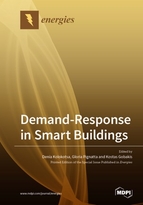Demand-Response in Smart Buildings
A special issue of Energies (ISSN 1996-1073). This special issue belongs to the section "G: Energy and Buildings".
Deadline for manuscript submissions: closed (20 May 2019) | Viewed by 39330
Special Issue Editors
Interests: energy management in the built environment; zero-energy buildings; integration of renewables in buildings and smart grids; solar energy applications; sustainable cities and communities; urban heat island and climate change
Special Issues, Collections and Topics in MDPI journals
Interests: sustainable building development; building energy efficiency; net-zero energy buildings; positive energy districts; climate adaptation and mitigation; energy transitions; energy poverty
Special Issues, Collections and Topics in MDPI journals
Interests: energy efficiency; built environment; energy management; renewable energy; smart building; power systems; building simulation; IoT
Special Issue Information
Dear Colleagues,
We would like to invite you to contribute to a Special Issue, entitled “Demand-Response in Smart Buildings”.
Demand response (DR) offers the capability to apply changes in the energy usage of consumers from their normal consumption patterns in response to changes in energy pricing over time. This leads to a lower energy demand during peak hours or during periods when an electricity grid’s reliability is put at risk. Therefore, demand response is a reduction in demand designed to reduce peak load or avoid system emergencies. Hence, demand response can be more cost-effective than adding generation capabilities to meet the peak and/or occasional demand spikes. The underlying objective of DR is to actively engage customers in modifying their consumption in response to pricing signals. Demand response is expected to increase energy market efficiency and security of supply, which will ultimately benefit customers by way of options for managing their electricity costs leading to reduced environmental impact. This Special Issue is focusing on the coupling of demand response with smart buildings and communities with the aim of covering alternative demand response approaches, case study analyses, research trends and necessary transformations in smart buildings and communities to be able to successfully implement demand response.
Prof. Dr. Denia Kolokotsa
Dr. Gloria Pignatta
Dr. Kostas Gobakis
Guest Editors
Manuscript Submission Information
Manuscripts should be submitted online at www.mdpi.com by registering and logging in to this website. Once you are registered, click here to go to the submission form. Manuscripts can be submitted until the deadline. All submissions that pass pre-check are peer-reviewed. Accepted papers will be published continuously in the journal (as soon as accepted) and will be listed together on the special issue website. Research articles, review articles as well as short communications are invited. For planned papers, a title and short abstract (about 100 words) can be sent to the Editorial Office for announcement on this website.
Submitted manuscripts should not have been published previously, nor be under consideration for publication elsewhere (except conference proceedings papers). All manuscripts are thoroughly refereed through a single-blind peer-review process. A guide for authors and other relevant information for submission of manuscripts is available on the Instructions for Authors page. Energies is an international peer-reviewed open access semimonthly journal published by MDPI.
Please visit the Instructions for Authors page before submitting a manuscript. The Article Processing Charge (APC) for publication in this open access journal is 2600 CHF (Swiss Francs). Submitted papers should be well formatted and use good English. Authors may use MDPI's English editing service prior to publication or during author revisions.
Keywords
- Demand response
- Smart Grids
- Building user behavior
- Energy Management








